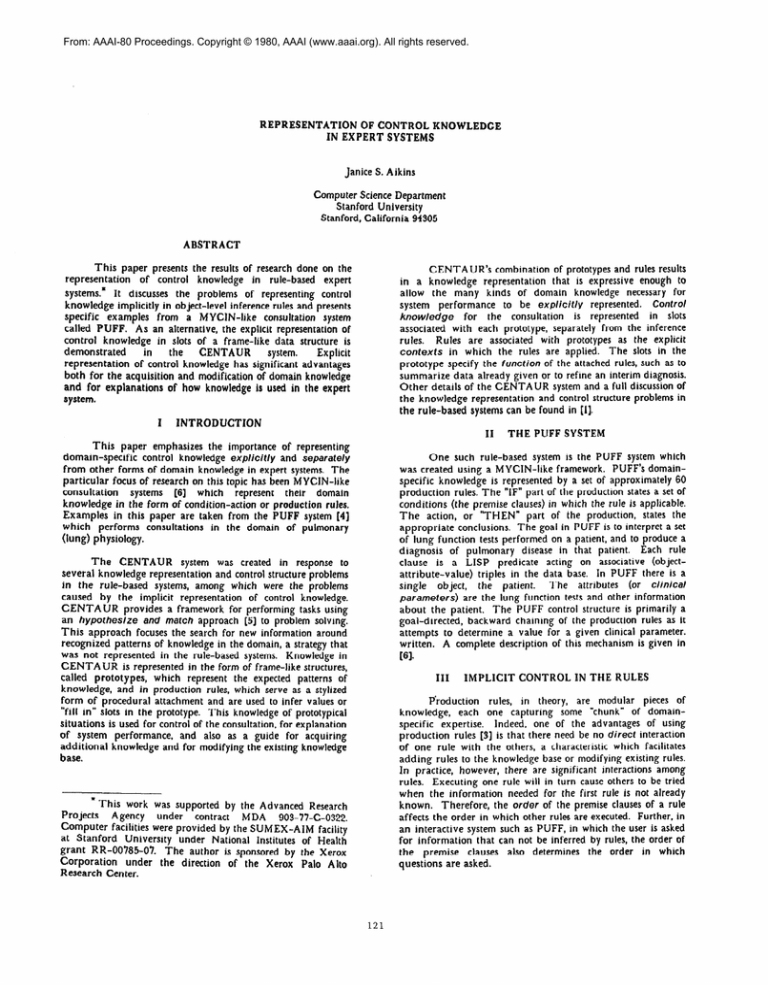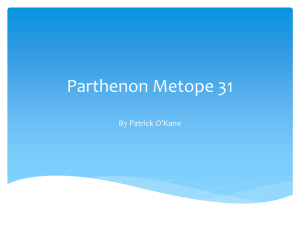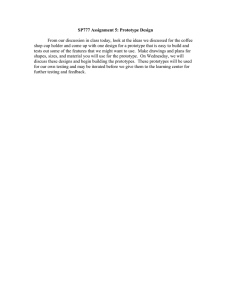
From: AAAI-80 Proceedings. Copyright © 1980, AAAI (www.aaai.org). All rights reserved.
REPRESENTATION OF CONTROL KNOWLEDGE
IN EXPERT SYSTEMS
Janice S. Aikins
Computer Science Department
Stanford University
Stanford, California 94305
ABSTRACT
This paper presents the results of research done on the
representation
of control knowledge in rule-based expert
systems.’ It discusses the problems of representing co&o1
knowledge implicitly in object-level inference rules and presents
specific examples from a MYCIN-like consultation system
called PUFF. As an alternative, the explicit representation of
conerol knowledge in sloes of a frame-like data structure is
demonstrated
in
the
CENTAUR
system.
Explicit
representation of control knowledge has significant advantages
both for the acquisition and modification of domain knowledge
and for explanations of how knowledge is used in the expert
system.
I
CENTAUR’s combination of prototypes and rules results
in a knowledge representation that is expressive enough to
allow the many kinds of domain knowledge necessary for
system performance to be explicitly represented. Control
know/edge
for the consultation is represented in slots
associated with each prototype, separately from the inference
rules. Rules are associated with prototypes as the explicit
contexts in which the rules are applied. The slots in the
prototype specify the function of the attached rules, such as to
summarize data already given or to refme an interim diagnosis.
Other details of the CENTAUR system and a full discussion of
the knowledge representation and control structure problems in
the rule-based systems can be found in [I].
INTRODUCTION
II
This paper emphasizes the importance of representing
domain-specific
control knowledge explicitly and separately
from other forms of domain knowledge in expert systems. The
particular focus of research on this topic has been MYCIN-like
consultaeion
systems [S] which represent their domain
knowledge in the form of condition-action or production rules.
Examples in this paper are taken from the PUFF system [43
which performs consultations in the domain of pulmonary
(lung) physiology.
TME PUFF SYSTEM
One such rule-based system is the PUFF system which
was created using a MYCIN-like framework. PUFF’s domainspecific knowledge is represented by a set of approximately 60
production rules. The “IF” part of the productlon states a set of
conditions (the premise clauses) in which the rule is applicable.
The action, or “THEN” part of the production, states the
appropriate conclusions. The goal in PUFF is to interpret a set
of lung function tests performed on a patient, and to produce a
diagnosis of pulmonary disease in that patient. Each rule
clause is a LISP predicate acting on associative (objectattribute-value)
triples in the data base. In PUFF there is a
The attributes (or clinical
single object, the patient.
parameters)
are the lung function tests and other information
about the patient. The PUFF control structure is primarily a
goal-directed, backward chaining of the production rules as it
attempts to determine a value for a given clinical parameter.
written. A complete description of this mechanism is given in
The CENTAUR system was created in response to
several knowledge representation and control structure problems
in the rule-based systems, among which were the problems
caused by ehe implicit representation of control knowledge.
CENTAUR provides a framework for performing tasks using
an hypothesize and match approach [5] to problem solving.
This approach focuses the search for new information around
recognized patterns of knowledge in the domain, a strategy that
was not represented in the rule-based systems. Knowledge in
CENTAUR is represented in the form of frame-like structures,
called prototypes, which represent the expected patterns of
knowledge, and in production rules, which serve as a stylized
form of procedural attachment and are used to infer values or
“fill in” slots in the prototype. This knowledge of prototypical
situations is used for control of the consultation, for explanation
of system performance, and also as a guide for acquiring
additional knowledge and for modifying the existing knowledge
base.
E61.
III
IMPLICIT
CONTROL IN THE RULES
P’roduction rules, in theory, are modular pieces of
knowledge, each one capturing some “chunk” of domainspecific expertise. Indeed, one of the advantages of using
production rules [3] is that there need be no direct interaction
of one rule with the others, a characteristic which facilitates
adding rules to the knowledge base or modifying existing rules.
In practice, however, there are significant interactions among
rules. Executing one rule will in turn cause others to be tried
when the information needed for the first rule is not already
known. Therefore, the order of the premise clauses of a rule
affects the order in which other rules are executed. Further, in
an interactive system such as PUFF, in which the user is asked
for information that can not be inferred by rules, the order of
the premise clauses also determines the order in which
questions are asked.
’ This work was supported by the Advanced Research
Projects
Agency
under contract MDA 903-77-C-0322.
Computer facilities were provided by the SUMEX-AIM facility
at Stanford University under National Institutes of Health
grant RR-00785-07. The author is sponsored by the Xerox
Corporation
under the direction of the Xerox Palo Alto
Research Center.
121
This means of controlling question order by placing
premise clauses in a specific order is, in fact, exploited by
experts who recognize the need for ordering the questions that
are asked, but have only this implicit and indirect mechanism
for achieving their goal. In this case, the production rule
framework itself becomes a programming language where the
rules have multiple functions; some rules represent independent
chunks of expertise with premise clauses specified in an
arbitrary order, while others serve a controlling function with
premise clauses that cannot be permuted without altering the
behavior of the system.
A system’s explanations of its own performance also
suffer when information
critical to performance is not
represented explicitly. The rule-based systems studied generate
explanations of why questions are being asked using direct
translations of those rules which were being used when the
question was asked. (See [2] for details.) There is no distinction
made between rules that control a line of reasoning, as opposed
to rules that infer a piece of information. However, users of the
system should be able to ask both kinds of questions in order to
obtain justifications of the system’s reasoning process as well as
justifications of its inference rules. The uniform representation
of control and inference knowledge in rule-based systems
further
confuses the user by mixing the two kinds of
explanations.
An example of implicit control knowledge is illustrated
by the PUFF rule in Figure I below. This rule invokes other
rules in an attempt to determine whether there is Obstructive
Airways Disease. (Clause One), and if so, to determine the
subtype (Clause Two) and findings associated with the disease
(Clause Three). If Clause One were inadvertently placed after
either Clause Two or Three, the system’s questions of the user
would probe for more detailed information about Obstructive
Airways Disease without having confirmed that the disease is
present. For example, by reordering the clauses in RULEOOP,
PUFF might begin its consultation by asking about the patient’s
smoking
history, one of the findings associated with
Obstructive Airways Disease, and a question that would be
inappropriate
in a patient without a smoking-related disease.
However, this rule contains no explicit indication that the order
of the clauses is critical. The problem with implicit
representation
of control knowledge becomes apparent in
working with the knowledge base, either to modify the
knowledge or to explain its use in the system.
IV
CONTROL KNOWLEDGE IN CENTAUR
Control knowledge about the process of pursuing an
hypothesis in CENTAUR is represented in slots associated with
each prototype, separate from the inference knowledge which
will actually confirm or deny the hypothesis represented as
production rules. Each slot specifies one or more LISP clauses,
or control tasks, that are executed at specific points during the
consultation as defined by a top-level prototype representing
the “typical” consultation (the CONSULTATlON Prototype).
For the
pulmonary
function
domain, prototypes
correspond
to specific pulmonary diseases.
During a
CENTAUR consultation, initial case data suggest one or more
disease prototypes as likely matches. Control knowledge in
these prototypes then guides the consultation by specifying what
information should be sought next. Expected data values in
each prototype enable CENTAUR to pinpoint inconsistent or
erroneous
information
during
the consultation.
Final
conclusions are presented in terms of the prototypical situations
determined to be present in the case, and any inconsistencies
are noted.
RULE882
----B-s
If:
1) An attempt has been made to deduce the
degree of obstructive
airways disease
of the patient,
2) An attempt has been made to deduce the
subtype of obstructive
airways disease,
and
has been made to deduce the
3) An attempt
findings
about the diagnosis
of
obstructive
airways disease
Then : It is definite
(1.8) that there is an
interpretation
of potential
obstructive
airways disease
Thus the system developer can specify “what to do” in a
given prototype context as an important part of the knowledge
about the domain that is distinct from the inferential
knowledge used in the consultation. These control tasks are
specified as LISP functions, and the system developer can
define any new functions as they are required. For example,
Figure 2 shows CENTAUR’s representation of the control
knowledge in the PUFF rule shown in Figure I. The control
knowledge is represented in two of the control slots associated
with the Obstructive Airways D’isease (OAD) prototype. They
specify that when OAD is confirmed (the If-Confirmed Slot),
the next tasks are to deduce a degree and a subtype for OAD,
and, at a later stage in the consultation (when the prototype
ACTION slots are executed), to deduce and print findings
associated with OAD.
FIGURE 1. PUFF Rule--Implicit Control
Modifying rules is a normal part of system development.
Clauses often must be added to or removed from rules in
response to perceived errors or omissions in the performance of
the system. However, removing or modifying the clauses of a
controlling rule can alter the system’s behavior in unexpected
ways, since the implicit control knowledge also will be altered.
Therefore, modifications can be safely done only by persons
intimately familiar with the knowledge base. This factor not
only limits the set of people who can make modifications, and
of course precludes the success of automatic knowledge
acquisition
systems in which each rule is considered
individually, but it also limits the size of the knowledge base, as
even the best of knowledge engineers can retain familiarity with
only a limited number of rules at a time.
If-Confirmed Slot:
Deduce the Degree of OAD
Deduce the Subtype of OAD.
Action Slot:
Deduce any Findings associated
Print the Findings associated
with OAD
with OAD
FIGURE 2. OAD Prototype Control Slots
122
Prototypes
not only represent the domain-specific
knowledge of a particular application, but also represent
domain-independent
knowledge about the operation of the
CENTAUR system. At the highest level in CENTAUR, the
Consultation
Prototype
lists the various stages of the
consultation (e.g., entering initial information, suggesting likely
prototypes, filling in prototypes) in its control slots. The
advantages of explicit representation of control knowledge thus
extend to control of the consultation process itself.
V
ADVANTAGES
VI
SUMMARY
This paper has discussed the importance of representing
control knowledge explicitly, particularly as it affects knowledge
acquisition and explanation in a knowledge-based system. The
representation of control knowledge as slots in a prototype in
the CENTAUR
system demonstrates one feasible approach.
Augmenting
the rule representation to include rules that
function exclusively as control rules might be another. The
critical lesson learned from working with the rule-based systems
is that the system’s representation structures must be expressive
enough to represent control knowledge explicitly, so that it will
not be inaccessible to the system and to the knowledge engineer.
OF THE CENTAUR APPROACH
The association of control knowledge with individual
prototypes allows control to be specific to the prototype being
explored. Thus domain experts can specify a different set of
control tasks for each prototypical situation. In the pulmonary
domain, for example, the expert proceeds in a different way if
he has confirmed OAD rather than some other disease in the
patient. Further, because this control knowledge is separate
from the inference rules, the expert does not have to anticipate
and correct incidental interactions between control and
inference knowledge.
ACKNOWLEDGMENTS
Many thanks to Doug Aikins, Avron Barr, Jim Bennett,
Bruce Buchanan, and Bill Clancey for their helpful advice and
comments on earlier versions of this paper.
Representing the entire consultation process itself as a
prototype
has additional
advantages.
First, the system
designer’s conception of the consultation process is clearly
defined for all system users. Second, representing each stage of
the consultation as a separate control task allows stages to be
added or removed from the consultation process. For example,
the Refinement Stage, which uses additional expertise to
improve upon an interim conclusion, was omitted during early
stages of system development for the pulmonary function
problem.
“Filling in” a consultation prototype with userspecified options, such as a choice of strategy for choosing the
current best prototype (for example, confirmation, elimination,
or fixed-order),
results in a control structure that can be
tailored to the desires of each individual user.
REFERENCES
[l] Aikins,
Prototypes
and Production
W/es:
A
J.
Computer
Representation
for
Knowledge
Consultations. (Forthcoming Ph. D. Thesis), Heuristic
Programming
Project, Dept.
Stanford University, 1980.
of
Computer
Science,
[Z] Davis R. Applications of Meta Level Knowledge to the
Construct/on,
Maintenance
and Use of
Large
Stanford
STAN-CS-76-552,
Bases.
Knowledge
Universlty, July 1976.
[3] Davis R., and King, J. An Overview of Production
Systems. In E. W. Elcock and D. Michie (Eds.), Machine
lntelllgence 8. New York: Wiley & Sons, 1977. Pp. SOO-
The
organization
of knowledge into prototypical
situations allows the user to more easily identify the affected set
of knowledge when changes to the knowledge base are desired.
Points at which specific control knowledge is used during the
consultation are clearly defined, with the result that it is easier
to predict the effects of any control modifications that may be
made.
332.
[4] Kunz, J., Fallat, R., McClung, D., Osborn, J., Votteri, B.,
Nii, H., Aikins, J., Fagan, L., and Feigenbaum, E. A
Physiological
Rule Based System for
Results.
Pulmonary
Function
Test
lnterpretlng
HPP-78-19
(Working Paper), Heuristic Programming Project, Dept.
of Computer Science, Stanford University, December
1978.
Explicit
representation
of control knowledge also
facilitates explanations about that knowledge. In addition to
the HOW and WHY keywords available in MYCIN, a new
keyword, CONTROL, has been defined so that a user of the
system can inquire about the control task motivating the
current line of reasoning. For example, if the user types
“CONTROL”
in response to a system question about the
patient’s smoking history, the system would respond, The
current control task Is to determine the findings associated
[5] Newell, A. Artificial Intelligence and the Concept of Mind.
In R. Schank and K. Colby (Eds.), Computer Models of
Thought and Language. San Francisco: W. H. Freeman
and Company,l973. Pp. l-60.
with OAD.
E. H. MYCIN: A Rule-based Computer
Regarding
Physicians
Advising
Program
for
Antimicrobial Therapy Selection. Ph. D. dissertation in
f6j Shortliffe,
Medical
Information
Sciences, Stanford University,
1974. (A Iso, Computer-Based Medical Consultations:
MYCIN. New York: American-Elsevier, 1976.
123





